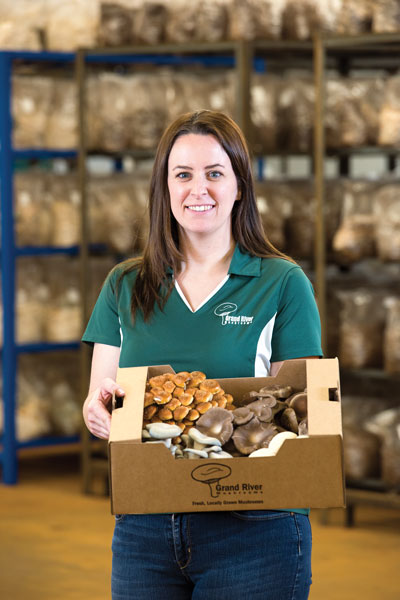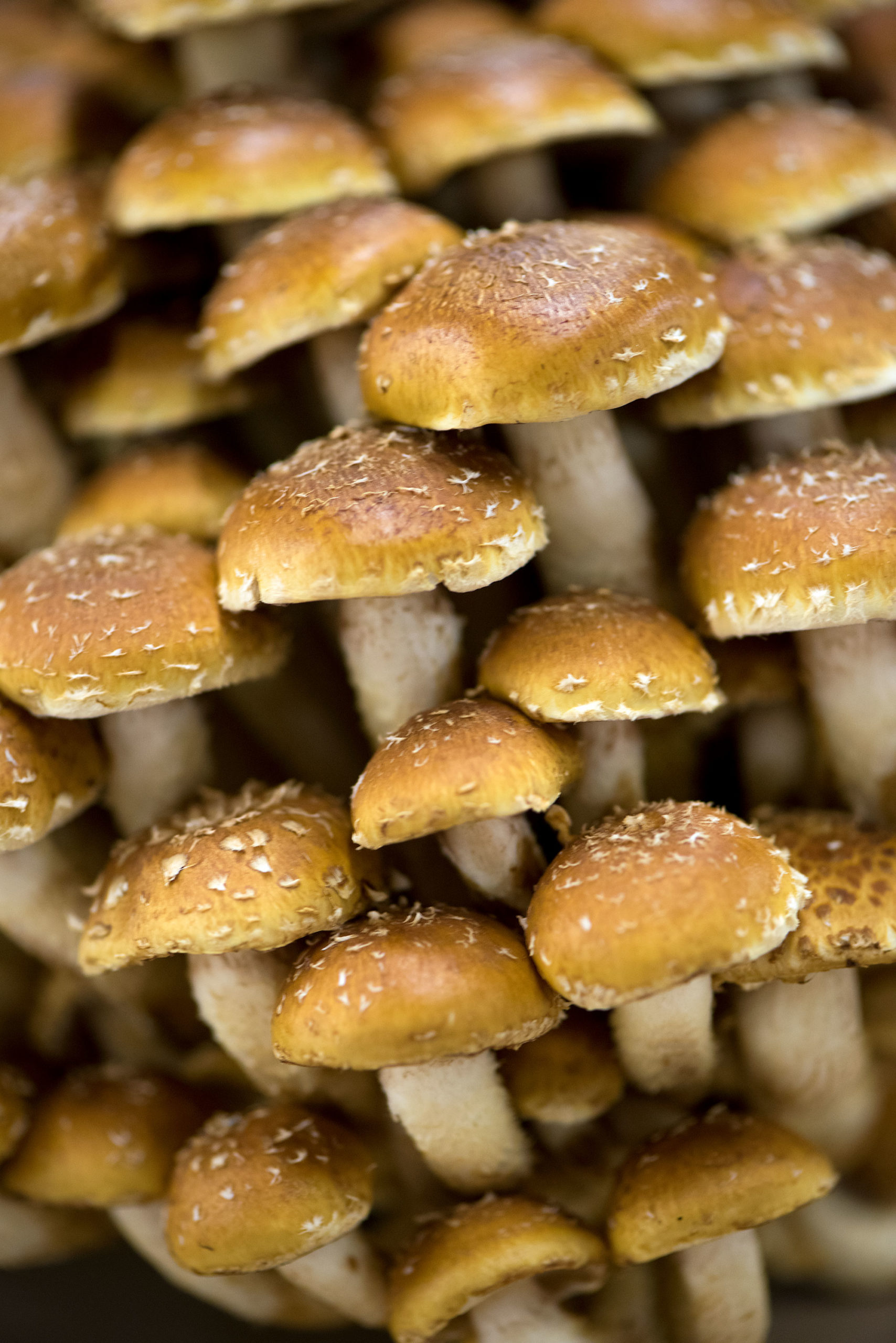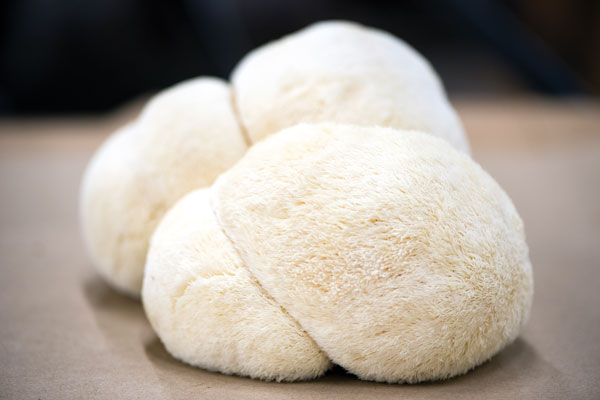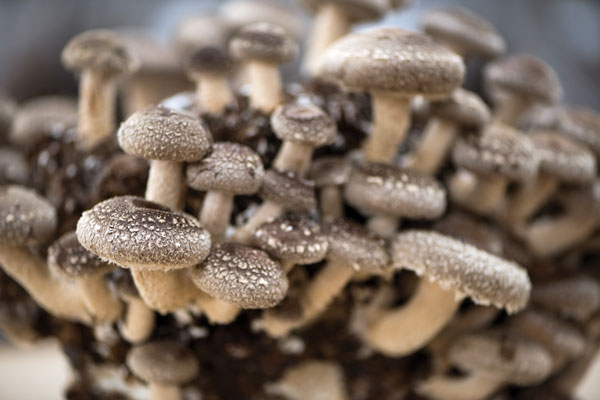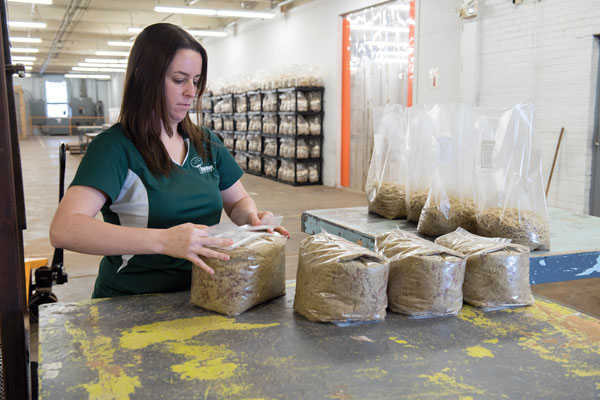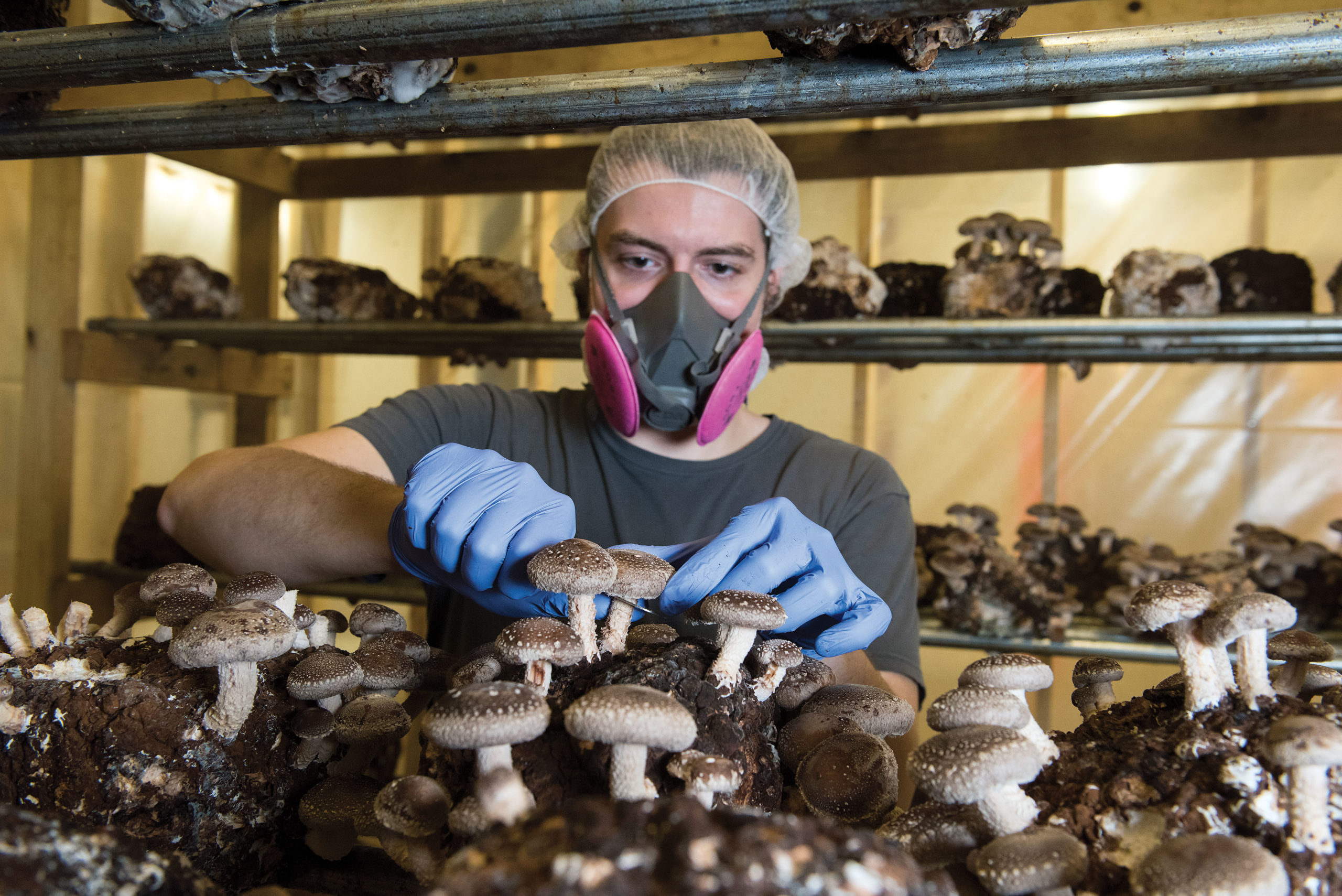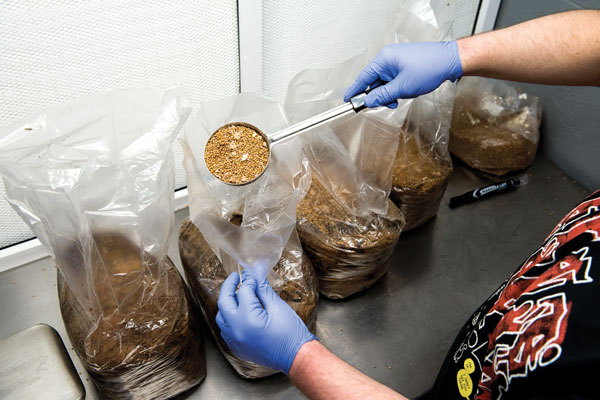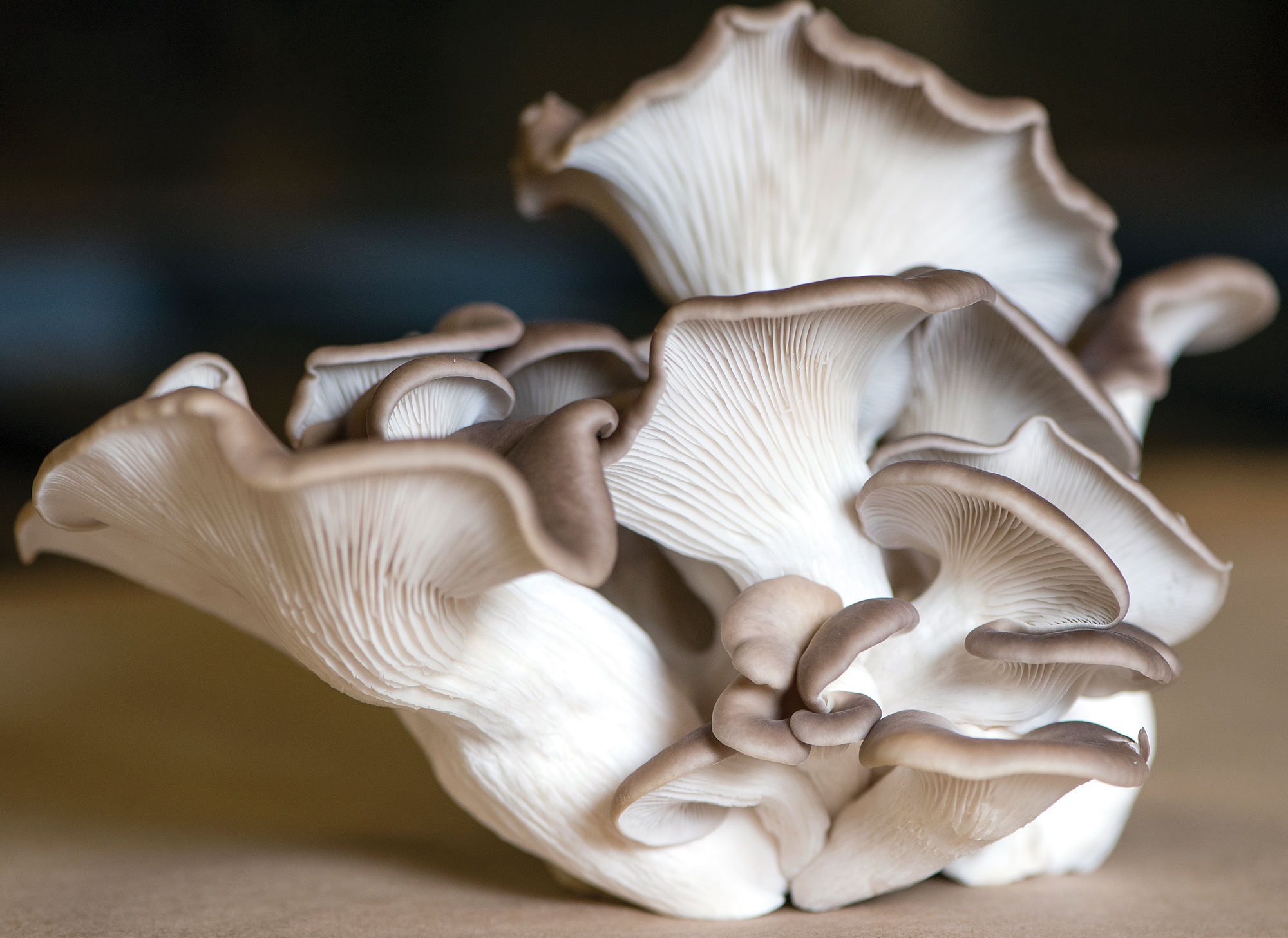
Farming Fungus
December 2, 2020
Written By Jason Jenkins
It’s late January, and a thick blanket of newly fallen snow covers the rolling farm ground of north Missouri. While it’s been months since Matt and Madison Larkin finished combining corn and soybeans, their harvest continues.
Just down the road from the farm in the town of Hamilton, tucked inside an old shoe factory, a different kind of cash crop is growing. Since 2017, the Larkins have produced specialty mushrooms. Their business, Grand River Mushrooms, began in the family’s 1,200-square-foot two-car garage. Today, it occupies a 45,000-square-foot industrial space where they grow shiitake, lion’s mane, cinnamon cap and two varieties of oyster mushrooms that they deliver directly to chefs.
“Matt’s a third-generation row-cropper, but we both have an entrepreneurial spirit,” says Madison, who oversees the mushroom business and the company’s five other employees, including her brother, Marshall Suchsland. “We knew we wanted to provide food for people.”
After brainstorming opportunities for a year-round business, they decided to focus on fancy fungus. Madison says the choice was ironic because she never really was a fan of mushrooms.
“When it comes to food, I’m a texture person, and button mushrooms and portabellas never really appealed to me,” she says. “When we realized that we lived in kind of a mushroom desert when it came to locally produced gourmet varieties, we decided to give it a try.”
The Larkins spent months learning the ins and outs of mushroom production while building their business concept. They decided to focus on restaurants in the Kansas City region.
“A lot of wholesalers won’t even handle some of these mushrooms because they’re fragile and don’t have long shelf lives, so we knew there was opportunity,” Madison says. “But, if we were going to be a wholesale supplier for chefs, we knew we had to be able to produce consistently. We needed to grow at least 100 pounds each and every week before we even thought about approaching restaurants.”
She says they started with blue oysters because they’re one of the easiest to grow. After roughly 10 months of research and development, the Larkins felt confident in both their product and their ability to supply it. Their first client: The Rieger in the Crossroads District of Kansas City, Mo.
“We love their product. It’s great,” says Adam Yoder, The Rieger’s chef de cuisine. “They offer really fresh mushrooms, the flavor is great and their attention to detail is reflected in the quality. They also offer a couple varieties that others don’t grow.”
Adam says his favorites are the shiitakes. The restaurant’s culinary team uses the mushroom caps in many dishes, but they also utilize the stems, which are fermented and then dehydrated to produce a mushroom powder.
“It’s become a staple ingredient for seasoning at the restaurant,” the chef adds. “It’s really a flavor booster for many dishes.”
Today, along with The Rieger, Grand River delivers 5-pound boxes of mixed mushrooms to more than 50 restaurant clients in the metro area.
’Shroom Steps
Overall, growing mushrooms is a relatively simple and straightforward process. It begins the same for all varieties: preparing the substrate.
“The substrate is to the mushroom what soil is to the seed. It’s the place to grow,” Madison explains. “We mix pelletized oak sawdust with water, and that’s our growing medium. We like using the pellets because the moisture is consistent every time.”
The substrate is placed in a plastic bag designed specifically for mushroom production. The bags feature a filter patch that allows airflow while preventing any contaminants from entering. Next, the bags are sterilized.
“We do atmospheric sterilization with steam. It’s not an autoclave that also uses pressure,” Madison says. “You’re just trying to provide a clean substrate for the mushrooms.”
The bags of substrate remain in the steamer for nearly 24 hours. Once removed and allowed to cool, they are then taken into the “clean room,” where an employee adds a substance called spawn — the mushroom producer’s equivalent of seed. The spawn has been inoculated with mycelium, the vegetative growth of a fungus. The bags are then sealed, shaken to evenly distribute the spawn throughout the substrate and placed on racks.
For the next few weeks to several months, depending on the mushroom variety, the bags will incubate on the racks at room temperature as the mycelium colonizes the substrate. Madison says the process slowly changes the substrate, both in color and composition.
“The mycelium is like the roots of the mushroom,” she says. “As it grows and colonizes the substrate, it’ll eventually turn completely white. It will also become very firm and form the sawdust into a block. We’re looking for 100 percent colonization.”
Once this stage is reached, the blocks are moved into the grow room where the fungus will produce edible mushrooms in a process known as fruiting.
“When it comes to the temperature of the grow room, our mushroom species are considered wide-range, so they can fruit from 40 degrees up to almost 80 degrees,” Madison says, adding that the temperature dictates the speed at which fruiting begins. “In the new grow rooms we’re setting up, we’ll keep the temp around 60 degrees.”
Each block produces roughly 2 pounds of mushrooms, though the yield varies by the growing conditions. The mushrooms are harvested by hand; only the prettiest will go into the regular mixed boxes. The less-than-perfect mushrooms, which they affectionately call the “uglies,” are sold at a discount.
Mushroom farming is labor intensive, Madison says. As production ramps up in the new facility in Hamilton, Grand River has designed its operations to be both scalable and as efficient as possible.
“We’re farming, but we wanted to create something that was almost factory-like in terms of efficiency,” she says. “When we started, we mixed substrate by hand and filled bags with a shovel. Now, we have a hopper with pneumatic gates that release a set volume of pellets and water into the bag with the push of a button.”
Reducing the number of times each substrate bag is handled has led to innovation. Instead of placing bags one by one into their homemade steamers — crafted from galvanized steel cattle tanks — they’ve created something Madison calls the “steam pod.” Once newly filled bags are placed into the pod, they don’t have to be handled again until they reach the clean room to be inoculated with spawn.
“We’re also working to eliminate stationary shelving,” she adds. “We’ve designed racks that will hold 100 bags. We can move these with a pallet jack from place to place rather than moving each bag individually. With our new system, we reduce the number of times we touch a bag from 12 to five. It’s more efficient and easier on our employees.”
Future Focus
Currently, Grand River produces 500 to 600 pounds of specialty mushrooms each week. Madison estimates that when completely built out, the new facility is capable of growing 5,000 pounds weekly.
Increased production is already allowing for growth into new markets beyond the Kansas City restaurant scene. In February, Grand River began making weekly deliveries to restaurants in Columbia and Jefferson City as well as Lawrence and Topeka, Kan. Madison says she’s also working to bring their mushrooms to farmers markets and grocery retailers in the Kansas City region this year. While retail pricing hasn’t been finalized, a cost of around $10 per pound is likely.
“We have lots of ideas for growing the business,” she adds. “I have a commercial dehydrator. As we get more grow rooms in operation, our plan is to dry down our extra mushrooms and sell them online. That’s the next phase.”
Another endeavor in the planning stages is the construction of a studio kitchen where invited chefs can share how they prepare mushrooms in their signature dishes.
“The first question I get from a lot of folks is, ‘What do I do with these?’” Madison says. “I’d love to have a YouTube channel and show all the great ways to prepare our mushrooms. They’re so flavorful and versatile.
The company also is experimenting with new mushroom varieties, including king oysters, pioppino, reishi, beech and maitake, a Missouri native more commonly known as Hen of the Woods.
“When you’re row-crop farming, you know you help feed people, but you don’t really see them,” Madison says. “Growing mushrooms, we know exactly who we’re feeding, and when you see a chef get excited about your product, that’s the best part.”
To learn more about Grand River Mushrooms, follow them on Facebook at www.facebook.com/grandrivermushrooms.


